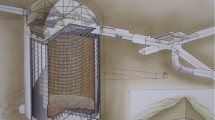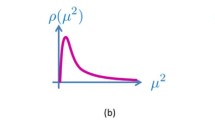Abstract
Motivated by the recent super-Kamiokande results on atmospheric neutrinos, we incorporate massive neutrinos, with large angle oscillation between the second and third generations, in a theory with R-parity violating supersymmetry. The general features of such a theory are briefly reviewed. We emphasize its testability through the observation of comparable numbers of muons and taus, produced together with the W-boson, in decays of the lightest neutralino. A distinctly measurable decay gap is another remarkable feature of such a scenario.
Similar content being viewed by others
References
Y Fukuda et al, Phys. Lett. B433, 9 (1998);
Phys. Rev. Lett. 81, 1562 (1998)
For reviews see, for example, H Haber and G Kane, Phys. Rep. 117, 75 (1985)
G Kane (ed), Perspectives in Supersymmetry (World Scientific, 1998)
G Farrar and P Fayet, Phys. Lett. B76, 575 (1978)
C Aulakh and R Mohapatra, Phys. Lett. 119, 136 (1982)
See, for example, V Barger, G Giudice and T Han, Phys. Rev. D40, 2987 (1989)
H Dreiner, hep-ph/9707435
D Choudhury and S Raychaudhuri, Phys. Lett. B401, 54 (1997)
R Barbier et al, hep-ph/9810232
M Drees et al, Phys. Rev. D57, 5335 (1998)
R Adhikari and G Omanovic, Phys. Rev. D59, 073003 (1999)
S Rakshit, G Bhattacharyya and A Raychaudhuri, Phys. Rev. D59, 091701 (1999)
See, for exaample, I-H Lee, Phys. Lett. B138, 121 (1984)
L Hall and M Suzuki, Nucl. Phys. B231, 419 (1984)
S Dawson, Nucl. Phys. B261, 297 (1985)
F Vissani and A Smirnov, Nucl. Phys. B460, 37 (1996)
M Nowakowski and A Pilaftsis, Nucl. Phys. B461, 19 (1996)
R Hempfling, Nucl. Phys. B478, 3 (1996)
S Roy and B Mukhopadhyaya, Phys. Rev. D55, 7020 (1997)
F de Campos et al, Nucl. Phys. B451, 3 (1995)
H P Nilles and N Polonsky, Nucl. Phys. B484, 33 (1997)
E Nardi, Phys. Rev. D55, 5772 (1997)
E Torrente-Lujan and J Valle, hep-ph/9808412
M Bisset et al, hep-ph/9811498
T Feng, hep-ph/9901260
F de Campos et al, hep-ph/9903245
See, for example, A Joshipura and M Nowakowski, Phys. Rev D51, 2421 (1995)
J Valle, hep-ph/9808292
B Mukhopadhyaya, S Roy and F Vissani, Phys. Lett. B443, 191 (1998)
V Bednyakov, A Faessler and S Kovalenko, Phys. Lett. B442, 203 (1998)
M Diaz, J Romao and J Valle, Nucl. Phys. Lett. B524, 23 (1998)
A K Datta, B Mukhopadhyya and S Roy, hep-ph/9905549
See, for example, S Bachall, P Krastev and A Smirnov, Phys. Rev. D58, 096016 (1998) and references therein
This is the approach taken here, following [10]. On the other hand, there exist studies which attempt to explain both the puzzles in terms of bilinear terms only [16]
A Joshipura and S Vempati, hep-ph/9808232
A Joshipura and S Vempati, hep-ph/9903435
K Scholberg, hep-ex/9905016
D Kaplan and A Nelson, hep-ph/9901254
S Choi et al, hep-ph/9903465
A K Datta, B Mukhopadhyaya and F Vissani, hep-ph/9910296
Author information
Authors and Affiliations
Rights and permissions
About this article
Cite this article
Mukhopadhyaya, B. Neutrino mass patterns, R-parity violating supersymmetry and associated phenomenology. Pramana - J Phys 54, 147–154 (2000). https://doi.org/10.1007/s12043-000-0013-5
Issue Date:
DOI: https://doi.org/10.1007/s12043-000-0013-5




